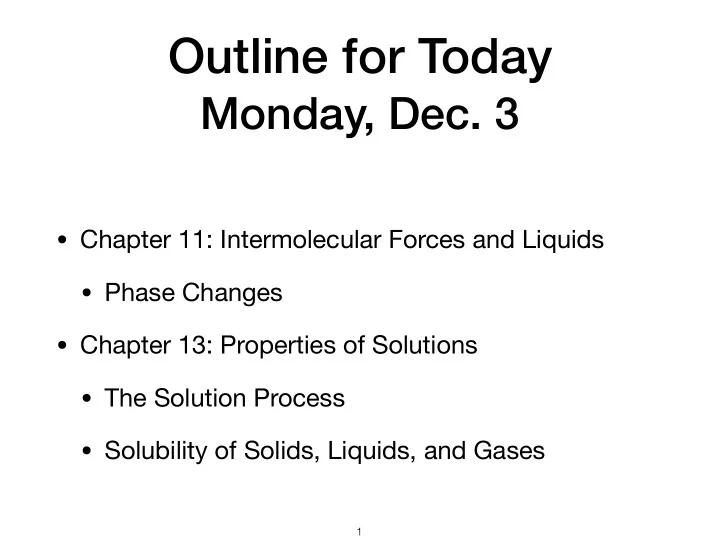

Outline for Today Monday, Dec. 3 • Chapter 11: Intermolecular Forces and Liquids • Phase Changes • Chapter 13: Properties of Solutions • The Solution Process • Solubility of Solids, Liquids, and Gases � 1
How do Vapor Pressure and Boiling Point Relate? Read the chart to rank the molecules by increasing vapor pressure at a given temperature. No Chart? Rank the molecules by IMF Rank the molecules by Boiling Point. The lower the boiling point, the higher the vapor pressure!
Example Problem: Reading Graphs • Which molecule has a boiling point closes to room temperature (25 o C)? • At 80 o C and 1 atm of pressure (760 torr), which molecules are liquids and which is a gas?
Phase Diagrams
Phase Diagrams: How To Read Them H 2 O Two independent variables: P and T Dependent variable: The phase or state of matter
Phase Diagrams: How To Read Them H 2 O Solid blue lines indicate phase changes. Triple Point : Indicated the Pressure and Temperature at which Solid Liquid and Gas Co-Exist
Important Points to Read from a Phase Diagram • Normal Boiling Point : Temperature at which the substance boils at 1 atm of pressure (760 torr) • Normal Freezing Point : Temperature at which the substance freezes at 1 atm of pressure (760 torr)
Phase Diagram for H 2 O • Critical Point : Temperature and Pressure beyond which the liquid and gas phases have the same density. They cannot be distinguished.
Example Problem: Phase Diagram for CO 2 • Describe the phase changes at 1 atm as the temperature decreases from room temperature to -200 o C. • What is the minimum pressure needed to create liquid CO 2 ?
When solutes are dissolved, the solvent’s phase diagram changes! Let’s learn why this happens in Chapter 13!
Chapter 13: Properties of Solutions Review of Key Terms: Solutions are homogeneous mixtures. Solvent : The dissolving medium of the solution Solute : The substance dissolved in the solvent. A smaller amount is present than the solvent. How do intermolecular forces between the solute and the solvent explain properties of solutions ?
Solution Mixing Is a Spontaneous Process Spontaneous Process
Definition of Spontaneous Colloquial Definition Spontaneous: occurring as a result of sudden inner impulse, without external stimulus or premeditation. Random, unexpected. Scientific Definition Spontaneous: Occurs of its own accord without any input energy from outside of the system
Solution Mixing Is a Spontaneous Process Spontaneous Process Why is this the most likely thing to happen? There are more ways to arrange O 2 and Ar when they spread out in the entire container, and when they are mixed together. Mixing leads to an increase in disorder. Mixing leads to an increase in entropy.
Making a Solution Hydration: The intermolecular interaction of water with solute
Intermolecular Forces in Solutions
More Definitions • Entropy : A thermodynamic state function that is related to the randomness or lack of order of a system. • Soluble : When a solute can be dissolved in a solvent. • Insoluble: When a solute cannot be dissolved in a solvent. • Miscible : When liquids mix in all proportions. • Immiscible : When liquids don’t mix.
Why wouldn’t mixing occur all of the time? Why would something precipitate? Solute-Solute IMFs Solute-Solvent Solvent-Solvent IMFs IMFs The Balance IMFs for the Enthalpy of Solution: ∆ H soln = ∆ H solute-solute + ∆ H solvent-solvent - ∆ H solute-solvent { { bonds broken bonds formed
A solution will form if the Solute- Solvent IMFs are stronger. Solute-Solute IMFs Solvent-Solvent IMFs Solute-Solvent IMFs ∆ H soln = ∆ H solute-solute + ∆ H solvent-solvent - ∆ H solute-solvent If ∆ H soln is exothermic , a solution is formed. The solution is a homogeneous mixture. The solute is solvable in the solvent.
A solution won’t form if the Solute- Solvent IMFs are much weaker Why would something precipitate? Solute-Solvent Solute-Solute IMFs IMFs Solvent-Solvent IMFs ∆ H soln = ∆ H solute-solute + ∆ H solvent-solvent - ∆ H solute-solvent If ∆ H soln is very endothermic, a solution will not be formed. A precipitate will be formed. No Homogeneous Mixture
If the Solute-Solvent IMFs are about the Same or Slightly Weaker, a Solution Will Form Solute-Solute IMFs Solute-Solvent Solvent-Solvent IMFs IMFs ∆ H soln = ∆ H solute-solute + ∆ H solvent-solvent - ∆ H solute-solvent If ∆ H soln is slightly endothermic, a solution may still be formed. The disorder of making the mixture makes up for the enthalpy cost.
Enthalpy of Making a Solution: Exothermic Example
Enthalpy of Making a Solution: Endothermic Example
Example Problem: Miscibility of two liquids • Do you expect hexane to be soluble in water? Why or why not? H 2 H 2 C C CH 3 H 3 C C C H 2 H 2
Example Problem to Try at Home • Vitamins can be either fat soluble or water soluble. Based on the molecular structure, is vitamin A fat soluble or water soluble? What about vitamin C? black=carbon gray=hydrogen typical fat molecule red=oxygen
Example Problem • Why is methanol (CH 3 OH) miscible in water but hexanol (CH 3 CH 2 CH 2 CH 2 CH 2 CH 2 OH) is not? H H 2 H 2 H 2 H C C C C OH H 3 C C C OH H 2 H 2 H methanol hexanol H H O water
Saturated Solutions • Saturated solution: A solution that is at equilibrium with undissolved solute. Additional solute will not dissolve. dissolve solute + solvent solution crystalize • The rate of dissolving is equal to the rate of crystalizing.
Supersaturated Solutions
Solubility of gases • Henry’s Law Solubility of a gas increases directly with increasing pressure More collisions with the surface of the liquid increases dissolving. S g = k P g
Temperature Effects • Solubility of most solids increase with temperature. • Solubility of gases decreases with increasing temperature.
Recommend
More recommend